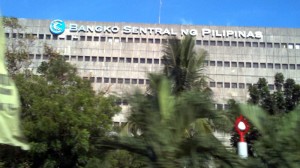The Bangko Sentral ng Pilipinas may increase its key interest and special deposit account (SDA) rates by 25 basis points during the monetary setting this Thursday in view of better-than-expected second-quarter economic data and resilient inflation pressures, an economist from Citigroup said.
In a research note, Citi economist for the Philippines Jun Trinidad also maintained gross domestic product (GDP) growth forecasts of 6.3 percent in 2014 and 6.5 percent in 2015. Output this second semester is seen better than the first.
Philippine GDP grew year-on-year by 6.4 percent in the second quarter from 7.9 percent in the same period last year. However, this was higher than the growth rate of 5.6 percent in the first quarter of 2014 and also exceeded the consensus growth forecast of 6.1 percent for the period. This brought average growth in the first semester to 6 percent.
“Inventory restocking coupled with fiscal spending de-compression and resumption of upbeat private construction would enable better second-half prospects,” Trinidad said. “Favorable second-half export outlook could sustain manufacturing output although we expect greater reliance on onshore catalysts.”
In the second quarter, Trinidad said manufacturing growth of 10.7 percent year-on-year provided the strong GDP catalyst together with services (6 percent) and farm output (3.6 percent). However, he noted that data were less upbeat on real investments alongside destocking despite strong manufacturing. Destocking refers to the reduction in inventory such as to improve a company’s efficiency, free up cash and reduce costs. Trinidad said such destocking “mirrored a cautious business outlook consistent with a 3.9-percent year-on-year import decline.”
Trinidad also noted that domestic demand growth narrowed to 4.4 percent year-on-year that was offset by a 6.2-percent contribution of net exports to GDP. He explained that strong Philippine peso exchange rate and higher inflation in the second quarter had curbed growth of overseas remittances, in turn restraining consumption gains.
Alongside sluggish investments and flat government consumption, domestic demand gains eased while upbeat exports (despite destocking) that cut imports uplifted net exports share of second-quarter GDP, the economist said.
Trinidad said that “better-than-expected second quarter GDP amid resilient inflation pressures bode well for hawkish BSP and its ensuing action of possibly another 25 basis points hike in the policy and SDA rates in September.”
The BSP’s overnight borrowing rate is at 3.75 percent and the SDA rate, 2.25 percent. It tinkered with the overnight borrowing rate for the first time since 2011 last July, raising the key rates by 25 basis points.
The SDA is a potent monetary tool created by the BSP to mop up excess liquidity in the system, offering higher-yielding deposit instruments at the central bank that can cascade even to retail investors. Over the years, this instrument has locked up more liquidity than overnight borrowings of the BSP.
“Benign rate hikes are consistent with gradual easing of negative real rates while cautious about causing long yields to spike that may discourage or stall long-term investments,” Trinidad said.
Negative real interest rates happen when the inflation rate is higher than the interest rate carried by benchmark instruments.
On Friday, it was reported that the country’s inflation rate for August stood at 4.9 percent year-on-year, the same level as the rate in July.
